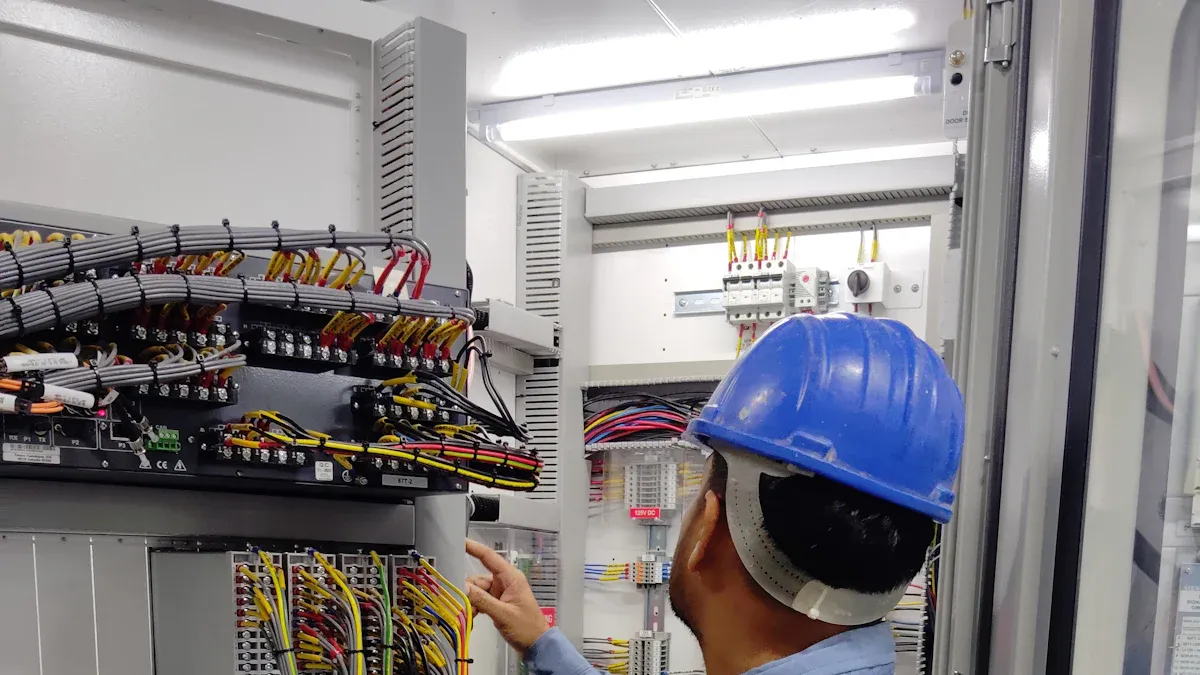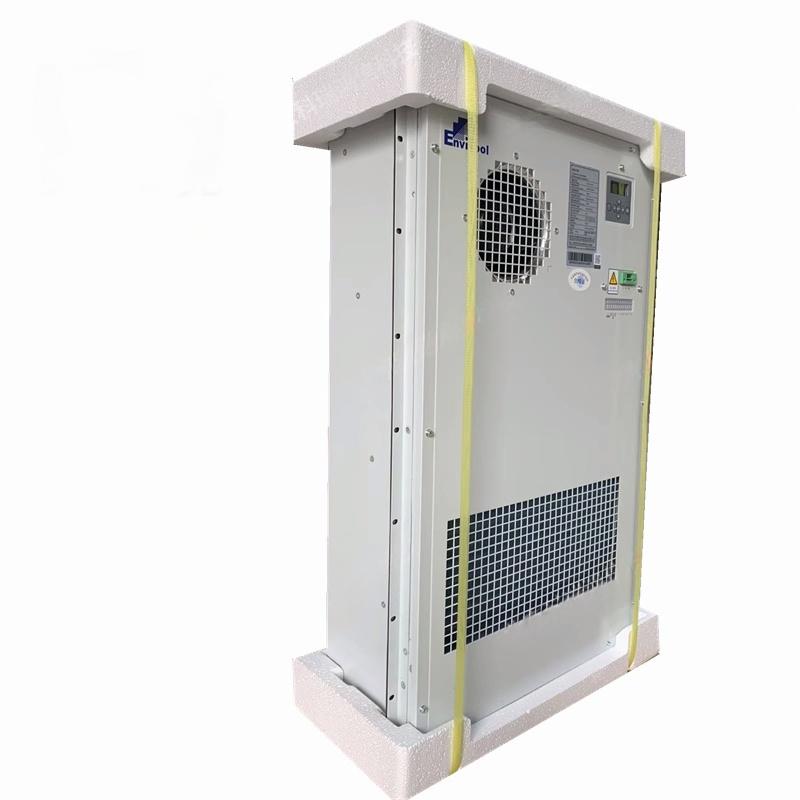5 Steps to Design Your Outdoor Battery Cabinet

Outdoor battery cabinets are essential for keeping your batteries safe from harsh weather conditions. When you design your outdoor battery cabinet, a well-thought-out design ensures optimal performance and longevity. Adhering to IP55 and IP67 standards prevents dust and water intrusion, making these cabinets ideal for outdoor use. Smart temperature control minimizes heat variations in the batteries, extending their lifespan. Additionally, improved cooling systems reduce energy consumption by 10%, promoting efficiency. By taking the time to design your outdoor battery cabinet, you safeguard your batteries and ensure they operate at their best.
Key Takeaways
Pick the correct size and kind of batteries for your energy use and local weather.
Use tough, weatherproof materials like plastic or polymer boards to stop rust and handle bad weather.
Add vents or fans to keep the batteries cool and working well.
Include safety items like locks, fireproof parts, and good wiring to keep batteries safe and avoid accidents.
Make the cabinet easy to open, simple to maintain, and ready for future upgrades as energy needs grow.
Step 1: Understand Your Requirements
Figure out the size and capacity of your cabinet
First, calculate how big your outdoor battery cabinet needs to be. This helps it fit your batteries and handle energy needs. Use this table for help:
Factor | How to Calculate or Consider |
|---|---|
Depth of Discharge (DOD) | Adjust capacity for DOD. For 50% DOD, double the size. |
Temperature Effects | Multiply capacity by 1.5 in cold areas to avoid drops. |
Voltage and Amp Hours | Find amp hours using Ah = Wh / V to know battery count. |
Wiring Configuration | Use series or parallel wiring to get the needed voltage and amp hours. |
These steps help you avoid choosing a cabinet that's too small or too big.
Choose the type and number of batteries
Picking the right batteries is key for your cabinet. Look at options like lead-acid or lithium iron phosphate batteries. Lead-acid ones need separation to stop corrosion, while lithium ones work more efficiently. Make sure they match popular brands and leave space between them. Add safety tools like hydrogen release devices to prevent problems. Think about how much energy you need now and later when deciding on the number of batteries.
Think about climate and location
Weather affects how your cabinet works. Extreme heat or cold can lower battery performance. In cold places, you might need extra insulation or heating. Use climate test chambers to check how your cabinet handles temperatures from -30°C to 70°C. These tests show design issues. Also, pick materials that can handle local weather, like heavy rain or strong sunlight, to make your cabinet last longer.
Tip: Add features like airflow and weatherproofing to keep your cabinet working well for years.
Step 2: Pick Strong Materials
Choose materials that can handle the weather outside
When making your outdoor battery cabinet, pick materials that can handle the weather. HDPE is a great choice. It's good for the environment and very strong. It can take on changes in temperature, rain, humidity, and sunlight without breaking down. This makes it a good pick for outside use.
Another good choice is polymer boards. They can stand up to sun, rain, saltwater, and snow. They are tough, waterproof, and need little care. Check out this table for their benefits:
Material | Weather Resistance | Durability | Maintenance Needs |
|---|---|---|---|
Polymer Board | Very resistant to sun, rain, saltwater, and snow | Strong, waterproof | Needs little care |
Tip: Pick materials that come in different colors and styles to match what you like.
Make sure it won't rust for lasting strength
Rust can make your cabinet weak over time. To stop this, pick materials that don't rust or rot. Stainless steel and aluminum are great picks. Stainless steel doesn't rust easily, and aluminum is light and strong. Both work well outside.
For extra safety, think about adding a weatherproof layer. This keeps water out and makes the cabinet last longer. Checking it often helps you find and fix rust early.
Keep costs low but quality high
Keeping costs low while getting good quality means your cabinet stays strong without spending too much. Fancy materials like stainless steel might cost more at first, but they save money later by needing less fixing and replacing. HDPE and polymer boards are cheaper but still strong and weatherproof.
Note: Always look at how materials perform, how much care they need, and their price to choose wisely.
Step 3: Plan for Ventilation and Cooling

Add airflow to stop overheating
Good airflow keeps your battery cabinet cool. Batteries get hot when charging or discharging. Without airflow, they can overheat. Use airflow studies to help design. For example:
Engineers use CFD models to study airflow in battery systems.
A 3D model shows air speed, flow, and temperature inside.
These help find hot spots and improve airflow to save energy.
By using these ideas, your cabinet stays at a safe temperature.
Use vents or fans to cool better
Vents or fans help cool your cabinet and stop overheating. Passive vents, like mesh, let air move naturally. Active cooling, like fans, cools more for high needs. Good airflow keeps batteries at the right temperature and lasts longer. Fans and vents spread heat well, keeping it safe inside. This makes your battery system work better.
Keep moisture out but allow airflow
Ventilation is key, but keep moisture away too. Outside, rain and humidity can harm batteries. Use weatherproof vents that let air in but block water. For example, slanted vents stop rain from getting in. Check and fix these often to keep them working. By balancing airflow and moisture protection, your cabinet can handle tough weather and work well.
Tip: Mix passive and active cooling for the best cabinet results.
Step 4: Ensure Safety Features
Use locks to stop unwanted access
Locks keep your outdoor battery cabinet safe from intruders. Smart locks are better than regular keys. They use digital tools like apps or fingerprints. Cameras and motion sensors can alert you if someone tries to break in.
For example, a telecom company used smart locks and cameras for its cabinets. This cut equipment downtime by 30%. It also saved money by catching break-ins early. Adding these features protects your batteries and keeps them running smoothly.
Tip: Check your locks often to make sure they work well.
Pick fireproof and waterproof materials for protection
Fireproof and waterproof materials keep your cabinet safe. They protect batteries from fire and water damage. Cabinets meeting EN 14470-1 or NFPA rules are safer. Type 30 cabinets resist fire for 30 minutes. Type 90 cabinets last up to 90 minutes.
Cabinet Type | Fire Resistance | Compliance Standards |
|---|---|---|
Type 30 | 30 minutes | EN 14470-1, FM Global, UL/ULC, OSHA, NFPA |
Type 90 | 90 minutes | EN 14470-1, FM Global, UL/ULC, OSHA, NFPA |
Using these materials helps your cabinet handle tough conditions. Waterproof materials also stop rain or floods from harming batteries.
Plan wiring and grounding to stay safe
Good wiring and grounding stop electrical dangers. Grounding avoids sparks that could cause fires. Follow NFPA 70 rules for safe setups. OSHA says flammable liquids need grounded containers to avoid sparks.
To stay safe:
Use grounding lugs for strong connections.
Ground all containers moving flammable liquids.
Check for hazards regularly.
These steps lower risks and keep your batteries safe.
Note: Always ask an electrician to check your wiring and grounding for safety.
Step 5: Design for Accessibility and Maintenance
Make it easy to reach batteries
Design your outdoor battery cabinet so you can easily get to the batteries. Use doors that open in the front or panels you can take off. This makes it simple to reach inside. Hinges that open wide or sliding parts help even more.
Think about how high the cabinet is. If it's at a good height, it's easier to work on. If there are many batteries, label each spot clearly. This way, you can find and change batteries fast.
Tip: Use quick-release clamps to hold batteries. They make changing batteries fast and easy.
Add features for regular checks
Regular checks keep your battery system working well. Design your cabinet for easy inspections. Use windows or clear panels to see batteries without opening the cabinet.
Put lights inside the cabinet. This helps you see when checking batteries, even if it's dark. Use cable holders to keep wires neat and stop them from tangling. Neat wires lower the chance of damage during checks.
Note: Check often to clean battery ends, tighten wires, and look for rust. A clean cabinet helps batteries last longer.
Plan for future changes
Your energy needs might grow. Design your cabinet so you can add more later. Leave room for more batteries or bigger ones.
Use designs that let you add on easily. For example, stackable parts or sections you can attach help it grow. Make sure the cabinet's electric system can handle more power.
Tip: Pick a design that can change easily. This way, your cabinet can meet new needs without big changes.
Creating your outdoor battery cabinet is simple with these five steps:
Check your needs to decide size, battery type, and weather effects.
Pick strong, weatherproof materials for lasting use.
Add cooling and airflow to stop overheating.
Include safety tools like locks, fireproof parts, and good wiring.
Make it easy to maintain and ready for future changes.
Remember: A good cabinet keeps batteries safe and works well. Start building today with a focus on strength, safety, and function. Your work now means dependable performance for many years ahead!
FAQ
Where should I place an outdoor battery cabinet?
Put the cabinet in a shaded spot to avoid sunlight. Place it on a flat, raised surface to stop water pooling. Keep it away from flammable items and flood-prone or harsh weather areas.
How can I keep the cabinet ventilated?
Add vents or fans to let air move freely. Use slanted vents to stop rain but allow airflow. Check and clean vents often to keep them clear and working well.
Are all batteries okay for outdoor cabinets?
Most batteries work, but they must fit the cabinet's design. Lithium iron phosphate and lead-acid batteries are popular options. Always follow the maker's rules for safe storage and spacing.
How often should I check my battery cabinet?
Look at your cabinet every three months. Search for rust, loose wires, or dirt buildup. Clean battery ends and make sure locks and grounding are working right.
What safety features should outdoor cabinets have?
Use locks to stop unwanted access, fireproof materials for emergencies, and waterproofing to block rain. Good wiring and grounding are also important to prevent electrical risks.
CALL US DIRECTLY
86-13752765943
3A-8, SHUIWAN 1979 SQUARE (PHASE II), NO.111, TAIZI ROAD,SHUIWAN COMMUNITY, ZHAOSHANG STREET, NANSHAN DISTRICT, SHENZHEN, GUANGDONG, CHINA

